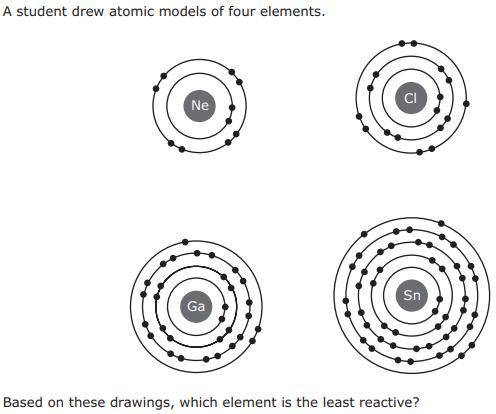20 points)
A.
Neon, because it has two energy levels with eight electrons in the second...

Biology, 10.02.2020 20:48 garcialopez162017
20 points)
A.
Neon, because it has two energy levels with eight electrons in the second level
B.
Chlorine, because it has three energy levels with seven electrons in the third level
C.
Gallium, because it has four energy levels with three electrons in the fourth level
D.
Tin, because it has five energy levels with four electrons in the fifth level


Answers: 1


Other questions on the subject: Biology

Biology, 22.06.2019 02:00, Ilovesnoopy69
1. emigration the movement of people from one place to another 2. immigration a situation in which resources are being used up at a faster rate than they can be replenished 3. migration the leaving of one's homeland to settle in a new place 4. overpopulation the movement of people to a new country 5. sustainable development a situation in which the birth rate is not sufficient to replace the existing population 6. underpopulation the ability to meet current needs without reducing the ability to meet future needs 7. unsustainable development the increase in the population of a city 8. urbanization a situation in which the number of people exceeds the available natural resources in an area
Answers: 2

Biology, 22.06.2019 04:40, meiyrarodriguez
The cluster of developing cells from conception until birth is called an
Answers: 1

Biology, 22.06.2019 06:50, Shaylaharrison15
The kidney filters potentially toxic substances in the blood, and thus “clears” the blood of those substances. this clearance function is dependent upon and proportional to the diffusion gradient of the substance across filtering capillaries, i. e. if the concentration of the substance is doubled, twice as much will be cleared from each ml of blood that is filtered. suppose that the body produces a constant amount of a substance x per unit of time. the kidneys eliminate substance x at a rate directly proportional to the concentration of the substance and the volume of blood cleared each minute (c): elimination = c × [x], where [x] is the steady-state concentration of substance x. imagine an individual with an initial concentration of x equal to [x]0 who develops kidney disease. her baseline clearance c0 drops to one half of the original (½c0). what is the new steady state concentration of x? (for simplicity, assume that substance x is 100% filtered by the kidney).
Answers: 1

Biology, 22.06.2019 10:30, krisayon8126
Error analysis: what might be the reason that some of your percentages didn't exactly match your predicted results? gametes aren't responsible for inheritance. mice don't have large litters, so the sample size was not large enough. the wrong type of mice were used.
Answers: 3
You know the right answer?
Questions in other subjects:


Mathematics, 21.04.2021 22:20





History, 21.04.2021 22:20



Medicine, 21.04.2021 22:20



